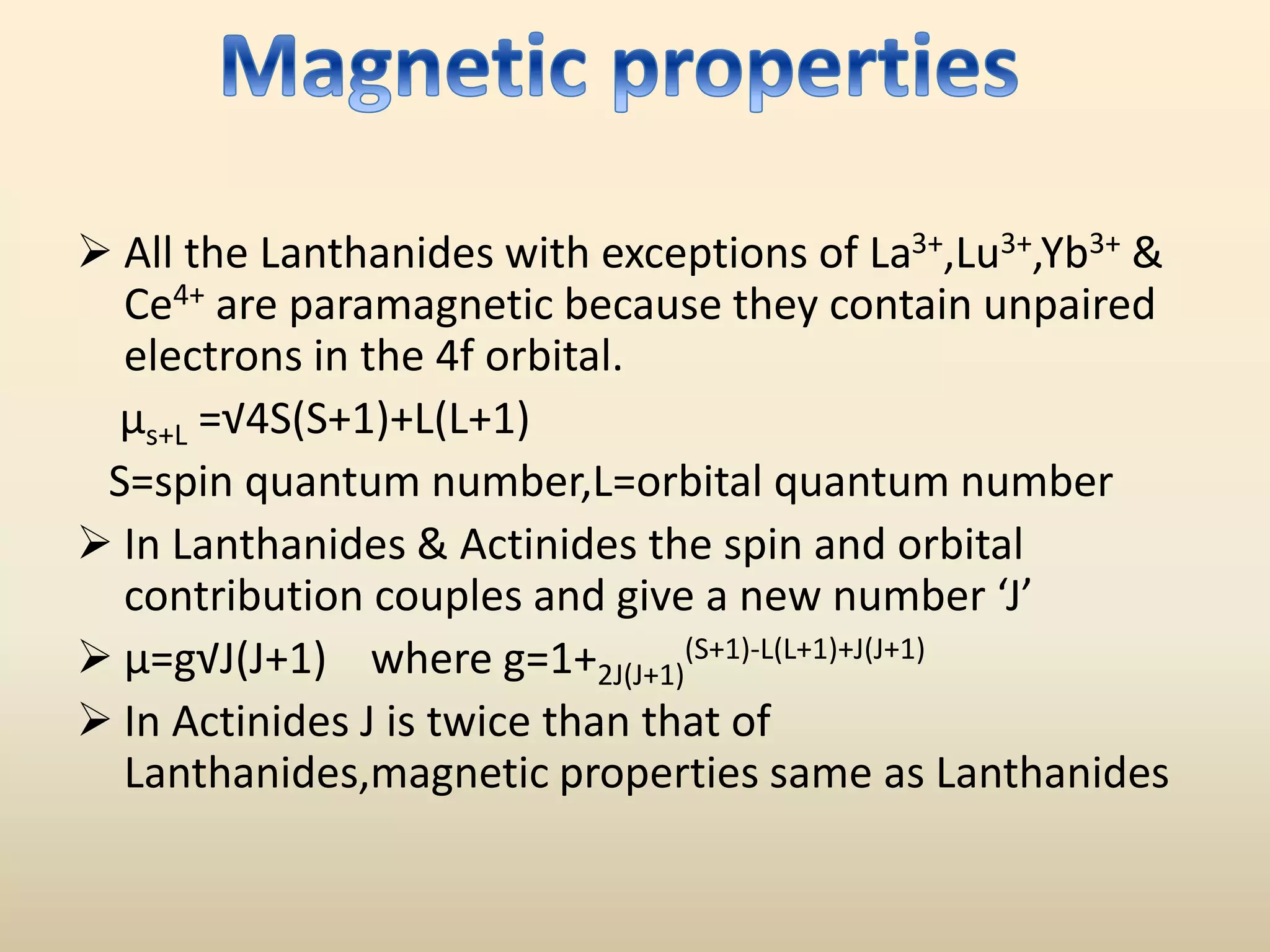The document discusses the lanthanides and actinides, which are groups of elements found below the main periodic table. There are a total of 30 elements between the lanthanides (elements 57-71) and actinides (elements 89-103). The lanthanides and actinides are often referred to as the "inner transition metals" and exhibit similar chemical properties to lanthanum and actinium, respectively.





![The common oxidation state shown by all the lanthanides is + 3. Some
elements display +2 and +4 oxidation states but these are always less stable
than the group valency +3. The unusual oxidation states touches +2 and +4
exhibited by the lanthanides can be explained on the basis of extra stability
associated with empty, half filled and fully filled 4f subshell.
• Eu and Yb exhibit +2 oxidation states:
This is because in +2 oxidation State Europium and Ytterbium acquire f7 and f14
electronic configuration.
Eu2+ [Xe] 4f7, Yb2+[Xe] 4f14
• Ce and Tb exhibit +4 oxidation states:
This is because in +4 oxidation State Cerium and terbium acquire f0 and f7
electronic configuration which are supposed to be stable configuration
Ce4+[Xe] 4f0 , Tb4+[Xe] 4f7](https://image.slidesharecdn.com/lanthanidesandactinides-200308183152/75/Lanthanides-and-actinides-6-2048.jpg)









![UO2(NO3 )2 .2H2O 350°c UO3
co,350°c UO2
U+O2 U3O8
700°c
All the oxides are basic & dissolve in acid
Some reactions of Fluoride
UO2
HF UF4
F
2,
240°c UF5
HF [UF6]-
HBr,65°c UF6 &[UF8]-
UF6 & UCl6 are octahedral but all other halides are
Polymeric & have higher coordination number.
UF6 obtained from colourless crystals and a
powerful Fluorinating agent.
AmO2
2+ is a strong oxidising agent like KMnO4](https://image.slidesharecdn.com/lanthanidesandactinides-200308183152/75/Lanthanides-and-actinides-16-2048.jpg)
![Since f electrons are
buried,ligands are placed
with minimal inter ligand
repulsion.Ln3+ being
large,hard lewis acid
adopted with high
coordination number.
CN of [Ln(H2O)n ]3+ =9 for
early lanthanides & 8 for
later. Yb3+ forms 7 CN
complex [Yb(acac)3)H2O]
&large La3+ forms 8CN
complex [La(acac)3(H2O)2]](https://image.slidesharecdn.com/lanthanidesandactinides-200308183152/75/Lanthanides-and-actinides-17-2048.jpg)



![• Luminescence of Lanthanide complex
Irradiation with UV light causes fluroscence in
Ln3+ complex. However, in some cases very
low temperature is required to observe this.
Origin of fluroscence- 4f-4f transition
[ No transition being possible for f0 , f7 (spin
forbidden) & f14 ]
e.g. Eu3+ (red emission) , Tb3+ (green emission)
are commercially useful.
• Lanthanoid metals
Lanthanum and lanthanoids crystallise in one or
both cubic or HCP lattice except
Eu(Europium). Eu crystallises in BCC .](https://image.slidesharecdn.com/lanthanidesandactinides-200308183152/75/Lanthanides-and-actinides-21-2048.jpg)



![e.g. 1. [Gd(DTPA)(OH2)]2- - Magnevist – was
approved in 1988 for medical use as an
MRI contrast agent .
2. [Gd(DTPA-BMA)(OH2)] - Omniscan
3. [Gd(HP-DO3A)(OH2)] - Prohance
These three are classed as extra-cellular
contrast agents(Once injected,they are
distributed non-specifically throughout
extra cellular fluids). Elimination is easy
through kidney with a halflife of around 90
minutes.](https://image.slidesharecdn.com/lanthanidesandactinides-200308183152/75/Lanthanides-and-actinides-25-2048.jpg)






![2005, GATE
63. LFSEs are smaller for lanthanides compared to TMs in the
oxidation state because
(a) Size of lanthanide ion are larger
(b) f orbitals interact less effectively with ligands
(c) size of lanthanide ion are smaller
(d) lanthanides favour oxygen donor ligands
64. The lanthanide complex (where, acac = acetylacetonate; phen-
1, 10-phenanthroline ) that do not have square antiprismatic
structure is
(a) [Ce(NO3)6 ]2- (b) [La(acac)3(H2O)2]
(c) [Ce(acac)4] (d) [Eu(acac)3(phen)]](https://image.slidesharecdn.com/lanthanidesandactinides-200308183152/75/Lanthanides-and-actinides-32-2048.jpg)

![2013, GATE
43. The correct electronic configuration and spin only magnetic
moment of Gd3+ (at. no. 64) are
(a) [Xe] 4f7 and 7.9 BM
(b) [Xe] 4f7 and 8.9 BM
(c) [Xe] 4f6 5d1 and 7.9 BM
(d) [Rn] 5f7 and 7.9 BM](https://image.slidesharecdn.com/lanthanidesandactinides-200308183152/75/Lanthanides-and-actinides-34-2048.jpg)

